The Brazos Review: AMD's E-350 Supplants ION for mini-ITX
by Anand Lal Shimpi on January 27, 2011 6:08 PM ESTHeavy Lifting: Performance in Complex Workloads
Brazos is clearly faster than Atom in light workloads, but what about in more complex/heavier applications? Are the Bobcat cores enough to allow E-350 systems to move up in the world or will they still be confined to the web browsing/email usage models of netbooks? I've run the E-350 through our entire Bench suite to find out. If you want the full gamut of results head over to CPU Bench, but I've chosen a few here. I also included performance results from a 2.66GHz Pentium 4 to put things in perspective for users of really old systems.
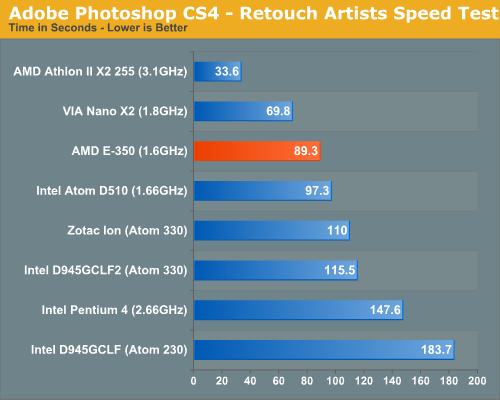
Photoshop CS4 performance is not half bad on the E-350 compared to other similarly priced platforms. Also impressive is the E-350's performance advantage over the old Pentium 4. Compared to the Athlon II X2 however the E-350 is still noticeably slower.
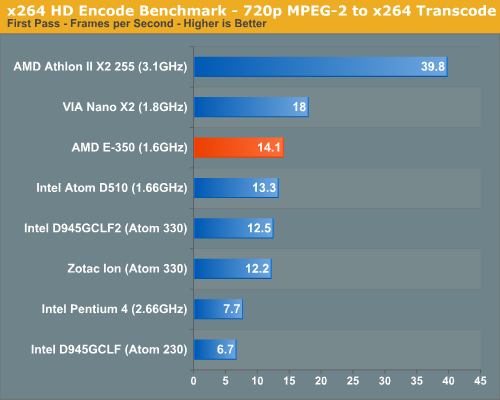
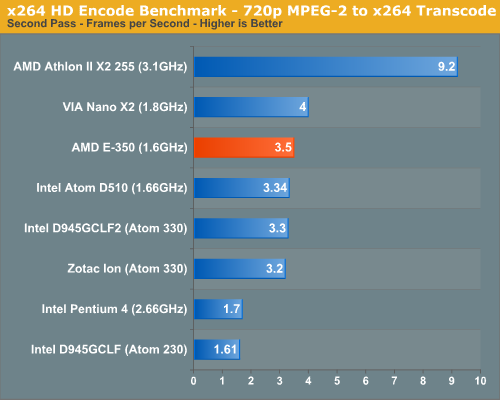
The standings and performance trends continue in our x264 encode benchmark. I don't expect you to do a lot of video transcoding on the E-350 as it's not much faster than Atom here. VIA's dual-core Nano is a bit quicker but still not enough to make this a viable usage case.
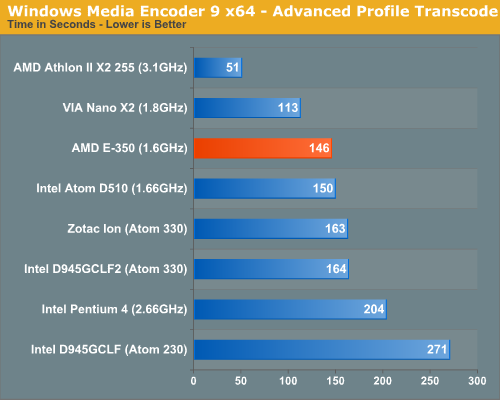
Windows Media Encoder provides a far lighter workload, but the standings don't change. The E-350 is faster than anything Atom based, faster than the old Pentium 4, but slower than VIA's Nano X2.
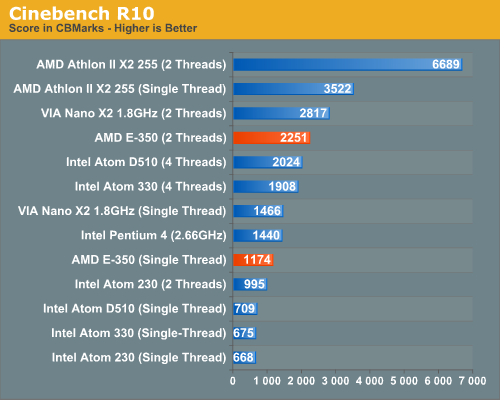
While I don't expect E-350 users to do any offline 3D rendering work, Cinebench does give us a good characterization of single threaded performance. The problem with Atom is that its single threaded performance isn't nearly as good as its multithreaded performance. In all of the previous benchmarks an Atom D510 is clearly quicker than the old 2.66GHz Pentium 4, but looking at single threaded Cinebench R10 you get a different story entirely. The P4 has nearly twice the single threaded performance of an Atom D510.
The E-350 is still a bit behind the Pentium 4 in single threaded performance, but it's not nearly as bad as Atom. The out-of-order execution engine helps tremendously here. What you get as a result is a system that doesn't really feel slower than a 5 year old PC but has the features of a more modern system.
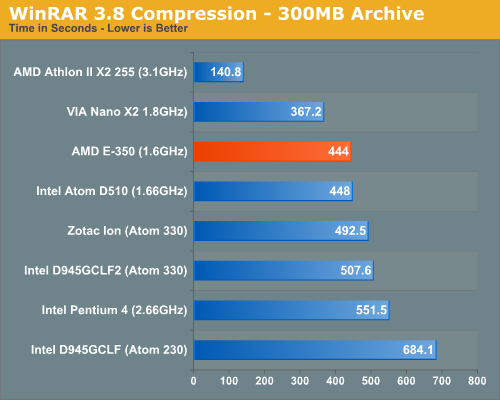
Overall the E-350 is clearly faster than Atom ever was at running these heavier workloads. The highly threaded workloads aren't much faster on E-350 vs. Atom thanks to the latter's Hyper Threading , but single threaded performance continues to play an important role and is a huge advantage of AMD's. VIA's simple out-of-order architecture is consistently faster than the E-350, however I don't expect to see widespread adoption or support for VIA's platform (at least compared to AMD's). Compared to the larger out-of-order x86 cores the E-350 is still in a lower performance class, the Athlon II X2 is easily twice as fast as the E-350 in these tests.
Ultimately the same rules that applied to Atom based systems apply to Brazos systems:
1) Swapping to disk is painful so you need enough memory (I'd recommend no less than 2GB for Windows 7, ideally 4GB) and you'll want a fast HDD. My preference is still an SSD, even a low end value drive over even a fast hard drive. Even a low end SSD (e.g. Kingston SSDNow V100) will make a Brazos system feel acceptably fast.
2) Outside of media playback and some gaming, you're still limited in the types of applications and workloads you can run on Brazos. The Brazos platform is great for web browsing/email workloads, but don't try to do too much more with it. The advantage over Atom here is that Brazos just does those things noticeably faster.










176 Comments
View All Comments
Belard - Tuesday, February 1, 2011 - link
It would fail at bluRay 3D.the 1080i is a bit unimportant since flatscreen TVs don't do interlace.
doctorpink - Tuesday, February 1, 2011 - link
if i remember correctly, nano runs 1.8ghz and is much faster but more power hungry...are there netbooks with nano anyway?
grego3d - Tuesday, February 1, 2011 - link
I'm sold on this Sandy Bridge / Atom killer. Well, maybe not Sandy Bridge killer yet, but i'm sure the second generation fusion processors will be. Now I need help finding a great little mini-itx case. I'd love to build a mini pc the size of my Wii. I have found a few small cases, but where on earth are the slot feed DVD/BD players. I always start my daily reading right here @ Anandtech.com so please save me some time and help us all out by rounding up a case review for this new Fusion platform. Go AMD Fusion - Boo Intel (and your 1$Billion oops!)Belard - Tuesday, February 1, 2011 - link
Sure is such excitement over such a tiny chip.It also reminds me why one of the P4s Dells I use at work is sooooooooooo Slooooooooooooooow.
I'll admit I'm using my very old computer (AMD X2 3800) as an HTPC somewhat, since it wasn't worth selling when I upgraded. But its a 90watt CPU... so saving power is the big thing, eh?
lovansoft - Tuesday, February 1, 2011 - link
I've got an Acer Aspire 5517 with an AMD Athlon tk-42 processor and integrated HD3200 video. It's also 1.6 Ghz so I wanted to showcase a relative clock for clock comparison. It is a 20W chip with 1meg cache built on a 65nm process and no VT. It's not an Athlon II, just an Athlon 64 x2, I believe.On Cinebench R10:
Single Thread: E-350=1174, TK-42=1340 :-: 1174/1340 = 87.6%
2 Threads: E-350=2251, TK-42=2373 :-: 2251/2373 = 94.4%
(1174+2251=3425)/(1340+2373=3713) = 92.2%
Scaling seems better on the new chips than on the older ones.
At idle with the screen off the laptop pulls about 18 watts. In Cinebench on a single thread it pulls about 30 watts, with 2 threads it pulls about 33 wats. Opening the screen to run the LCD at full brightness adds about 9 watts at any time.
I ran these tests with a Kill-A-Watt meter. It's not quite an exact comparison, but is pretty close. But to see that they kept performance close, added graphics, and still managed to shave 10% off TDP it's pretty dang impressive.
lovansoft - Tuesday, February 1, 2011 - link
Actually, I just let my laptop sit idle for a while. Now, idle power usage dips down to 11 watts with the lid closed and generally stays switching between 11-13 watts. Hmmm, the power usage on these new chips aren't quite as I would expect unless it's a platform thing. This article shows that the new chips pull 9W at full load under Cinebench. My testing shows I ramp from about 12W up to 33W which is a 21W increase by taxing the TK-42, right inline with the 20W spec giving my rounding of numbers. All other parts being equal and I only ramp up 9W instead of 21W then my peak should be about 12W less, or about 21W total instead of 33W total. That would be a significant gain. Interesting that this article has the new platform at 32.2W with the same workload. That's about 50% higher than my rough estimations. Is it because it's a desktop board and not a laptop design?sebanab - Wednesday, February 2, 2011 - link
Thanks for the performance comparison. I really helps putting the Zacate into perspective.On the power consumption comparison:
Ofcourse the desktop board system will consume more than a laptop with same specs.
Your laptop consumes less because of different PSU , less USBs , less components in general (PCIex) and so on.
So in order to make a correct comparison , wait for a HP DM1z review for example.
lovansoft - Wednesday, February 2, 2011 - link
I figured as much, but 50% seems high. But then again, it really is only a few watts... Lower efficiency PSU, a couple more chips to provide some extra ports. A couple of watts here and there do add up I suppose. And to think it provides more than 90% of my current performance into only 2/3 the power. I'd think if they can up it to 2Ghz it'd be about the same as mine without tapping the power too much. From the speculation I've read, it makes it seem that the revision coming in a year should grow the performance by quite a bit without really increasing power, about what you'd expect from a die shrink.You know, with this architecture, it'd be nice if a board could be made that would have multiples of these chips for server use. From my experience in SMB, I rarely find servers being CPU bound. Usually if they are, then there is some runaway process that needs to be tamed. Maybe this current generation isn't quite fast enough, but with a process shrink and some speed adjustments, getting a few of these on a board would make a very low energy server. But it'd only be feasible if there were something they could use that built in graphics portion for. Otherwise it'd be a waste.
Oh, and Cinnebench R10 on an AthlonXP 3000+ (2Ghz) = 1438.
Single Thread: E-350=1174, XP3000=1438 :-: 1174/1438 = 81.6%
1.6/2=80% Seems to be about the same IPC as the AthlonXP line.
I don't have power numbers for it, though.
torkemada - Wednesday, February 2, 2011 - link
Is E350IA-E45 board HDMI 1.4? Info on the net is confusing.Hrel - Thursday, February 3, 2011 - link
that VIA chip is pretty impressive.